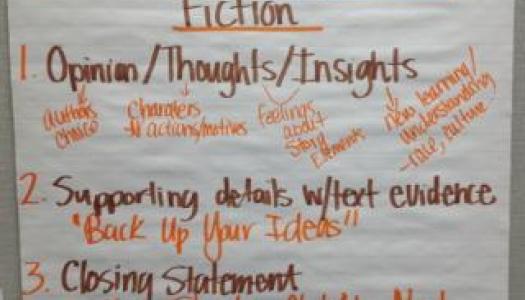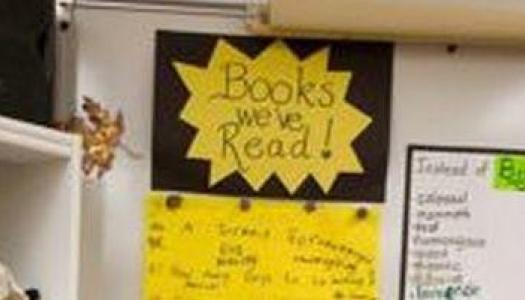Once Upon a Concept–Fun with Informational Text
Join Our Community
Access this resource now. Get up to three resources every month for free.
Choose from thousands of articles, lessons, guides, videos, and printables.
Who doesn't love a good story? There's certainly a lot to love in most stories: colorful characters with unique voices, interesting plots with twists and turns, and enchanting language that draws readers into another world. Although fiction has traditionally been a popular choice for read-alouds, informational text is a strong alternative that offers many benefits. By including high-interest informational read-alouds that reinforce "once upon a concept" instead of "once upon a time," teachers can help students learn to navigate the rich terrain of informational text. By selecting read-aloud texts created to inform, and not just to entertain, teachers can influence students' understanding of the world.
Benefits
One of the key advantages of using informational texts for an interactive read-aloud is that it helps students build background knowledge. The Common Core Reading Standards for Informational Text make clear that students must be well equipped to read texts that inform, think critically about those works, and respond to higher-level questions. As learners listen actively and discuss the text, they make progress toward the Speaking and Listening Standards. For a more complete look at expectations for students, teachers can consult their grade-level standards (National Governors Association Center for Best Practices & Council of Chief State School Officers, 2010).
Real-Life Application
Informational text most resembles what adults read in college, in the workplace, and in everyday life. It prepares students to process facts, interpret charts and tables, and follow directions. In addition, it offers young readers a chance to develop diverse interests that might range from architecture to cartooning to ocean life. Some readers naturally gravitate to nonfiction, and informational text can sometimes ignite the reading life of a struggling student.
Text Features and Structures
Interactive read-aloud for nonfiction encourages students to listen carefully for important concepts. Since interactive read-aloud removes the onus of decoding, all listeners, especially struggling readers, are free to enjoy the experience. The added value of carefully chosen, thoughtful teacher think-alouds makes the text more accessible for listeners. Stopping at preselected intervals, the teacher can invite children to discuss text elements that expand their critical thinking. By participating in cooperative structures such as turning to a partner and/or sharing in a small group, children voice their thoughts. Ultimately, it is this exchange of ideas that extends their learning.
When teachers read an informational text aloud to students, they can expose them to text features (such as tables of contents, captions, cutaways, photographs and illustrations, labels, glossaries, indexes, sidebars, hyperlinks, and more) that enable them to traverse their way successfully through the book or article. Because of the popularity of informational texts, many are now available in big-book format, making them ideal for classroom sharing. Teachers can point out selected text features as a springboard to discuss author's craft. By asking questions like "How did the author use headings to organize the article?" or "Why did the author decide to use a cutaway in this section?" the teacher can deepen students' understanding of author's craft and the writer's decision-making process.
With intermediate-grade students, the teacher can use an informational text read-aloud to call attention to the structures of chronology, comparison, and cause/effect. This attention to structure is crucial, because the Reading Standards for Informational Text call for students in grades four and beyond to have knowledge of text features so that they can expand their learning to include text structures (National Governors Association Center for Best Practices & Council of Chief State School Officers, 2010).
CAFE Menu Connections
For teachers who use CAFE (Boushey & Moser, 2009), an interactive read-aloud is a wonderful opportunity to model the strategies that make up the menu. Of course, the menu has applications for all types of texts, fictional and informational, and for various kinds of learning settings from individual conferring to whole-group mini-lessons. During a read-aloud, a teacher may plan to highlight or reinforce a certain strategy from the CAFE Menu.
As students listen to the reading of an informational text, the teacher can deepen their understanding by focusing on strategies from the COMPREHENSION section of the menu. Depending on the needs of the class and the text in hand, the teacher can decide which of these strategies to feature in a read-aloud and plan think-alouds accordingly. Of course, when working with small strategy groups or individual readers, the teacher can select informational texts that reflect children's interests.
While students are engaged in an interactive read-aloud of informational text, they have the opportunity to hear the teacher read the words with accuracy. Based on the ACCURACY section of the CAFE Menu, through interactive read-aloud, teachers can model any of the strategies. Again, because the text is informational, students gain background knowledge while paying close attention to pictures and words.
One of the reasons that interactive read-aloud has retained its popularity in a digital age is the human element: the teacher-reader has the power to enthrall listeners with an attention-getting, fluent oral reading of the text. In an interactive read-aloud focused on informational text, teacher-readers can channel enthusiasm, amazement, wonder, and curiosity. They can invite students into their own relationship with the text as they model strategies from the FLUENCY section of the CAFE Menu. Teachers can model how to convey the author's meaning through the skillful use of their voices.
As students listen to a read-aloud of an informational text, they encounter many content-specific words. They grow in their understanding of academic vocabulary. Discussions about words help students EXPAND VOCABULARY because they hear words that are not ordinarily used in everyday speech.
Promoting Informational Read-Aloud
Classroom teachers have opportunities to include informational text in their frequent read-alouds. At school literacy nights and parent-teacher conferences, and via family correspondence, they can encourage parents to consider choosing informational texts for their home read-alouds. They can invite guest readers to share their favorite informational texts. The school librarian is likely to oblige requests for classroom informational-text read-alouds as well.
The Common Core State Standards promote wide reading that includes a variety of texts; they also reinforce the importance of informational text. These standards invite teachers to continue to share high-quality fiction through their interactive read-alouds, but to include informational text as well. In turn, students' literary lives will be enriched by encountering fictional characters who live happily ever after and nonfiction concepts that live on in their understanding.
Works Cited
Boushey, G., & Moser, J. (2009). The CAFE book. Portland, ME: Stenhouse.
National Governors Association Center for Best Practices & Council of Chief State School Officers. (2010). Common Core State Standards for English language arts and literacy in history/social studies, science, and technical subjects. Washington, DC: Authors.







